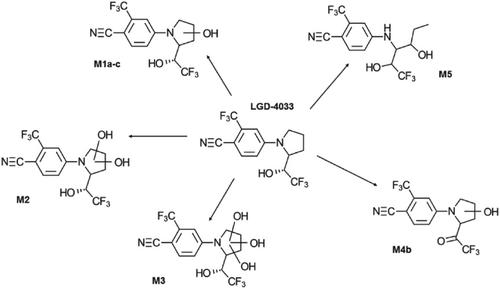当前位置:
X-MOL 学术
›
Drug Test. Anal.
›
论文详情
Our official English website, www.x-mol.net, welcomes your
feedback! (Note: you will need to create a separate account there.)
Investigation of the metabolism of the selective androgen receptor modulator LGD-4033 in equine urine, plasma and hair following oral administration.
Drug Testing and Analysis ( IF 2.6 ) Pub Date : 2020-01-05 , DOI: 10.1002/dta.2719 Charlotte Cutler 1 , Marjaana Viljanto 1 , Pamela Hincks 1 , Jocelyn Habershon-Butcher 2 , Tessa Muir 2 , Simon Biddle 1
Drug Testing and Analysis ( IF 2.6 ) Pub Date : 2020-01-05 , DOI: 10.1002/dta.2719 Charlotte Cutler 1 , Marjaana Viljanto 1 , Pamela Hincks 1 , Jocelyn Habershon-Butcher 2 , Tessa Muir 2 , Simon Biddle 1
Affiliation

|
LGD‐4033 is one of a number of selective androgen receptor modulators (SARMs) that are being developed by the pharmaceutical industry to provide the therapeutic benefits of anabolic androgenic steroids, without the less desirable side effects. Though not available therapeutically, SARMs are available for purchase online as supplement products. The potential for performance enhancing effects associated with these products makes them a significant concern with regards to doping control in sports. The purpose of this study was to investigate the metabolism of LGD‐4033 in the horse following oral administration, in order to identify the most appropriate analytical targets for doping control laboratories. LGD‐4033 was orally administered to two Thoroughbred horses and urine, plasma and hair samples were collected and analysed for parent drug and metabolites. LC‐HRMS was used for metabolite identification in urine and plasma. Eight metabolites were detected in urine, five of which were excreted only as phase II conjugates, with the longest detection time being observed for di‐ and tri‐hydroxylated metabolites. The parent compound could only be detected in urine in the conjugated fraction. Seven metabolites were detected in plasma along with the parent compound where mono‐hydroxylated metabolites provided the longest duration of detection. Preliminary investigations with hair samples using LC–MS/MS analysis indicated the presence of trace amounts of the parent compound and one of the mono‐hydroxylated metabolites. In vitro incubation of LGD‐4033 with equine liver microsomes was also performed for comparison, yielding 11 phase I metabolites. All of the metabolites observed in vivo were also observed in vitro.
中文翻译:

口服后马尿,血浆和头发中选择性雄激素受体调节剂LGD-4033的代谢研究。
LGD4033是制药行业正在开发的众多选择性雄激素受体调节剂(SARM)之一,可提供合成代谢雄激素类固醇的治疗益处,而又不会产生不良副作用。尽管无法进行治疗,但可以将SARM作为补充产品在线购买。与这些产品相关的提高性能的潜力使它们成为体育运动中兴奋剂控制的重要关注点。这项研究的目的是调查口服给药后马中LGD-4033的代谢,以便为兴奋剂控制实验室确定最合适的分析目标。LGD-4033口服给两匹纯种马和尿液,收集血浆和头发样品,并分析母体药物和代谢产物。LC‐HRMS用于尿液和血浆中的代谢物鉴定。尿液中检测到8种代谢物,其中5种仅作为II期结合物排泄,二羟基和三羟基代谢物的检测时间最长。母体化合物只能在结合部分的尿液中检测到。在血浆中检测到7种代谢物以及母体化合物,其中单羟基化代谢物提供了最长的检测时间。使用LC-MS / MS分析对头发样本进行的初步调查表明,存在痕量的母体化合物和一种单羟基化代谢物。尿液中检测到8种代谢物,其中5种仅作为II期结合物排泄,二羟基和三羟基代谢物的检测时间最长。母体化合物只能在结合部分的尿液中检测到。在血浆中检测到7种代谢物以及母体化合物,其中单羟基化代谢物提供了最长的检测时间。使用LC-MS / MS分析对头发样本进行的初步调查表明,存在痕量的母体化合物和一种单羟基化代谢物。尿液中检测到8种代谢物,其中5种仅作为II期结合物排泄,二羟基和三羟基代谢物的检测时间最长。母体化合物只能在结合部分的尿液中检测到。在血浆中检测到7种代谢物以及母体化合物,其中单羟基化代谢物提供了最长的检测时间。使用LC-MS / MS分析对头发样本进行的初步调查表明,存在痕量的母体化合物和一种单羟基化代谢物。在血浆中检测到7种代谢物以及母体化合物,其中单羟基化代谢物提供了最长的检测时间。使用LC-MS / MS分析对头发样本进行的初步调查表明,存在痕量的母体化合物和一种单羟基化代谢物。在血浆中检测到7种代谢物以及母体化合物,其中单羟基化代谢物提供了最长的检测时间。使用LC-MS / MS分析对头发样本进行的初步调查表明,存在痕量的母体化合物和一种单羟基化代谢物。还进行了LGD-4033与马肝微粒体的体外温育以进行比较,产生11种I期代谢物。所有观察到的代谢物在体内也观察到体外。
更新日期:2020-01-05
中文翻译:

口服后马尿,血浆和头发中选择性雄激素受体调节剂LGD-4033的代谢研究。
LGD4033是制药行业正在开发的众多选择性雄激素受体调节剂(SARM)之一,可提供合成代谢雄激素类固醇的治疗益处,而又不会产生不良副作用。尽管无法进行治疗,但可以将SARM作为补充产品在线购买。与这些产品相关的提高性能的潜力使它们成为体育运动中兴奋剂控制的重要关注点。这项研究的目的是调查口服给药后马中LGD-4033的代谢,以便为兴奋剂控制实验室确定最合适的分析目标。LGD-4033口服给两匹纯种马和尿液,收集血浆和头发样品,并分析母体药物和代谢产物。LC‐HRMS用于尿液和血浆中的代谢物鉴定。尿液中检测到8种代谢物,其中5种仅作为II期结合物排泄,二羟基和三羟基代谢物的检测时间最长。母体化合物只能在结合部分的尿液中检测到。在血浆中检测到7种代谢物以及母体化合物,其中单羟基化代谢物提供了最长的检测时间。使用LC-MS / MS分析对头发样本进行的初步调查表明,存在痕量的母体化合物和一种单羟基化代谢物。尿液中检测到8种代谢物,其中5种仅作为II期结合物排泄,二羟基和三羟基代谢物的检测时间最长。母体化合物只能在结合部分的尿液中检测到。在血浆中检测到7种代谢物以及母体化合物,其中单羟基化代谢物提供了最长的检测时间。使用LC-MS / MS分析对头发样本进行的初步调查表明,存在痕量的母体化合物和一种单羟基化代谢物。尿液中检测到8种代谢物,其中5种仅作为II期结合物排泄,二羟基和三羟基代谢物的检测时间最长。母体化合物只能在结合部分的尿液中检测到。在血浆中检测到7种代谢物以及母体化合物,其中单羟基化代谢物提供了最长的检测时间。使用LC-MS / MS分析对头发样本进行的初步调查表明,存在痕量的母体化合物和一种单羟基化代谢物。在血浆中检测到7种代谢物以及母体化合物,其中单羟基化代谢物提供了最长的检测时间。使用LC-MS / MS分析对头发样本进行的初步调查表明,存在痕量的母体化合物和一种单羟基化代谢物。在血浆中检测到7种代谢物以及母体化合物,其中单羟基化代谢物提供了最长的检测时间。使用LC-MS / MS分析对头发样本进行的初步调查表明,存在痕量的母体化合物和一种单羟基化代谢物。还进行了LGD-4033与马肝微粒体的体外温育以进行比较,产生11种I期代谢物。所有观察到的代谢物在体内也观察到体外。











































 京公网安备 11010802027423号
京公网安备 11010802027423号